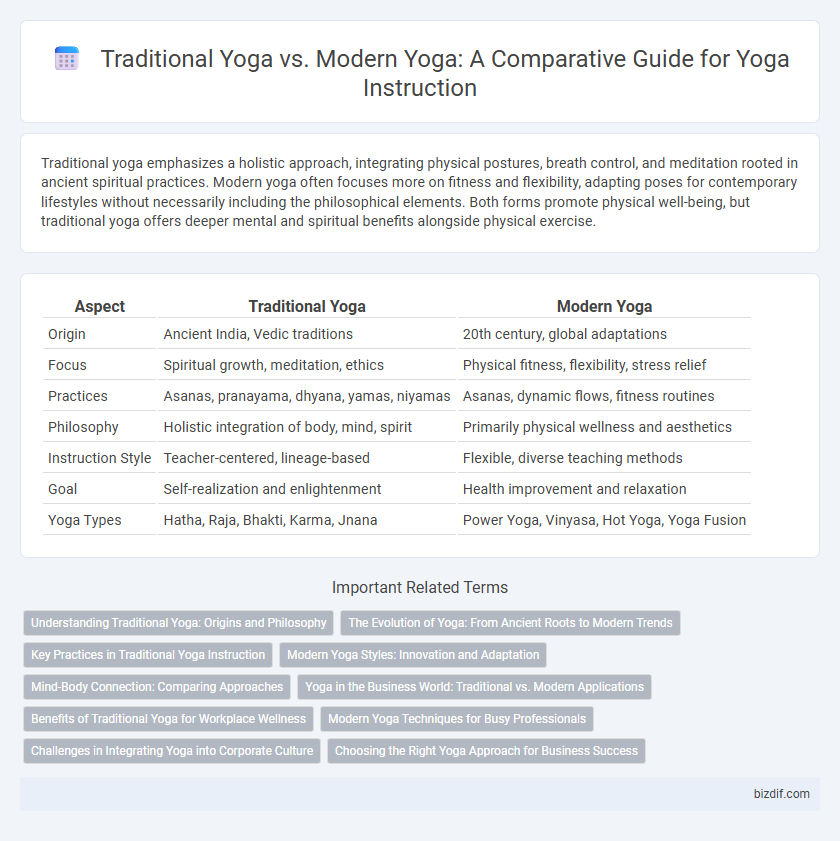Traditional yoga emphasizes a holistic approach, integrating physical postures, breath control, and meditation rooted in ancient spiritual practices. Modern yoga often focuses more on fitness and flexibility, adapting poses for contemporary lifestyles without necessarily including the philosophical elements. Both forms promote physical well-being, but traditional yoga offers deeper mental and spiritual benefits alongside physical exercise.
Table of Comparison
| Aspect | Traditional Yoga | Modern Yoga |
|---|---|---|
| Origin | Ancient India, Vedic traditions | 20th century, global adaptations |
| Focus | Spiritual growth, meditation, ethics | Physical fitness, flexibility, stress relief |
| Practices | Asanas, pranayama, dhyana, yamas, niyamas | Asanas, dynamic flows, fitness routines |
| Philosophy | Holistic integration of body, mind, spirit | Primarily physical wellness and aesthetics |
| Instruction Style | Teacher-centered, lineage-based | Flexible, diverse teaching methods |
| Goal | Self-realization and enlightenment | Health improvement and relaxation |
| Yoga Types | Hatha, Raja, Bhakti, Karma, Jnana | Power Yoga, Vinyasa, Hot Yoga, Yoga Fusion |
Understanding Traditional Yoga: Origins and Philosophy
Traditional yoga originates from ancient Indian spiritual practices dating back over 5,000 years, emphasizing a holistic approach that integrates physical postures (asanas), breath control (pranayama), meditation, and ethical disciplines (yamas and niyamas). Rooted in sacred texts like the Bhagavad Gita and Patanjali's Yoga Sutras, traditional yoga focuses on self-realization and uniting the mind, body, and spirit. Understanding this philosophy highlights yoga as a path to inner peace and spiritual awakening beyond physical exercise.
The Evolution of Yoga: From Ancient Roots to Modern Trends
Traditional yoga emphasizes holistic practices rooted in ancient Indian philosophy, including meditation, pranayama, and ethical disciplines, reflecting a spiritual and self-realization focus. Modern yoga often prioritizes physical postures (asanas), fitness, and stress relief, adapting traditional techniques to contemporary lifestyles and scientific understanding. The evolution of yoga showcases a dynamic integration of historical teachings with global wellness trends, expanding accessibility and diverse practice forms.
Key Practices in Traditional Yoga Instruction
Traditional yoga instruction emphasizes kriyas, pranayama, and meditation techniques that align with ancient Indian texts such as the Yoga Sutras of Patanjali and the Bhagavad Gita. Key practices include asanas performed with mindful breath control and dharana (concentration) to cultivate spiritual awakening and mental discipline. This approach prioritizes ethical guidelines (yamas and niyamas) and holistic development over purely physical fitness.
Modern Yoga Styles: Innovation and Adaptation
Modern yoga styles emphasize innovation and adaptation, integrating elements from fitness disciplines like Pilates and dance to enhance flexibility, strength, and mindfulness. These contemporary approaches often prioritize accessibility and personalization, catering to diverse body types and lifestyles while utilizing props and technology for optimized practice. By blending tradition with modern science, they offer dynamic routines that address mental health and physical wellness in today's fast-paced world.
Mind-Body Connection: Comparing Approaches
Traditional yoga emphasizes a holistic mind-body connection through meditation, breath control, and spiritual awareness, fostering deep inner harmony and self-realization. Modern yoga often incorporates physical fitness elements and accessible postures, prioritizing flexibility, strength, and stress relief. Both approaches enhance mental clarity and physical health but differ in their focus on spiritual growth versus exercise-based wellness.
Yoga in the Business World: Traditional vs. Modern Applications
Traditional yoga emphasizes holistic wellness through disciplined practices like pranayama, meditation, and classical asanas rooted in ancient Indian philosophy. Modern yoga in the business world focuses on stress reduction, improved productivity, and employee well-being, often adapting poses and breathing techniques for office environments. Corporations increasingly integrate yoga programs combining traditional mindfulness with contemporary fitness trends to enhance workplace culture and reduce burnout.
Benefits of Traditional Yoga for Workplace Wellness
Traditional yoga enhances workplace wellness by improving mental clarity, reducing stress through pranayama (breath control), and promoting physical flexibility that counters sedentary office habits. Its holistic approach integrates mindfulness and ethical practices, fostering emotional balance and resilience in high-pressure environments. Regular practice of asanas and meditation in traditional yoga supports sustained energy levels and reduces burnout, leading to increased productivity and overall employee well-being.
Modern Yoga Techniques for Busy Professionals
Modern yoga techniques cater specifically to busy professionals by emphasizing efficiency and stress relief through shorter, high-intensity sessions like power yoga and Vinyasa flow. These methods integrate mindfulness with physical fitness, improving flexibility, strength, and mental clarity within limited time frames. Incorporating technology, such as online classes and apps, enhances accessibility and allows for personalized practice schedules tailored to demanding lifestyles.
Challenges in Integrating Yoga into Corporate Culture
Integrating traditional yoga, rooted in spiritual practices and mindfulness, into fast-paced corporate culture faces challenges such as aligning ancient philosophies with productivity-driven environments. Modern yoga adaptations emphasize physical fitness and stress relief, but often dilute traditional holistic benefits, creating gaps in authentic practice within workplaces. Bridging these differences requires tailored programs that respect yoga's origins while meeting corporate demands for wellness and performance enhancement.
Choosing the Right Yoga Approach for Business Success
Traditional yoga emphasizes classical postures, spiritual discipline, and breath control rooted in ancient Indian philosophy, appealing to clients seeking holistic wellness and mental clarity. Modern yoga adapts these practices with a focus on physical fitness, accessibility, and contemporary wellness trends, attracting a broader, diverse clientele interested in flexibility and stress relief. Selecting the right approach for business success depends on target audience preferences, with traditional yoga aligning with niche markets and modern yoga offering scalable options for mainstream fitness centers.
Traditional yoga vs Modern yoga Infographic

 bizdif.com
bizdif.com